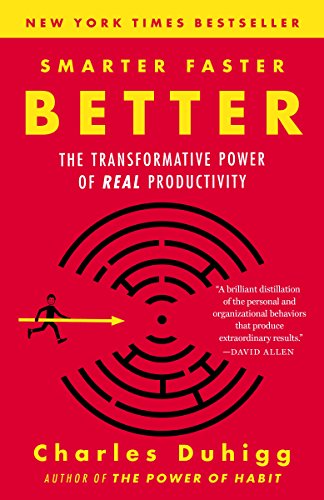The majority of students go through their education without much intentionality. Sick of falling into that category and ready to set goals and reap the results? You’re in luck!

Smarter Faster Better
by Charles Duhigg
⏱ 15 minutes reading time
🎧 Audio version available
The fact that a lot of students just go through the motions to get their degrees comes down to the belief that a degree will get them everything they’ve ever wanted career-wise. However, you can’t land your dream job on being more or less aimless.
Some students try to be ambitious, but a lot of the goals they set end up lingering on their to-do lists. You could blame it on being overwhelmed, on bad timing, on life getting in the way, et cetera, but at the end of the day, these goals don’t lead them anywhere.
That’s why SMART goals exist. They’re a game-changer.
The word “SMART” doesn’t just refer to their brilliance. SMART stands for: specific, measurable, attainable, relevant or realistic or results-focused, and timely.
The purpose of setting goals is obvious. They’re incredibly useful! Setting SMART goals help lessen the pressure and divide the workload better. They can allow you to easily monitor your progress. They definitely help you manage your time better and more efficiently. And, of course, their ultimate purpose is working smarter instead of harder.
As a student, now more than ever is the moment to learn how to go about setting goals. Once you master them, you’ll be set for the rest of your career. This is how you can tailor them to your needs, both now and in the future.
Specific
Let’s start with the “S.” The first requirement to set a SMART goal is to be specific. This way, you have a much better chance of accomplishing this clearly defined goal than a general, vague goal. To give an example, instead of saying “Write presentation,” say, “Write an intro for the presentation,” and follow that up with more specific goals.
A nice way to set a specific goal is to find the answer to these questions, aka all questions beginning with the letter “W.”
What? This is one that is pretty straightforward. What do you want to accomplish?
Why? Be specific about the reason behind your goal, its benefits, and what you expect out of accomplishing it.
Which? This is the part where you focus on the requirements of the goal. Do you have any constraints?
When? This is your deadline. Creating a deadline and a time frame for accomplishing your goal is imperative.
Who? And lastly, we have “who,” which are the people involved in your goal.
Once you have figured out the answer to each of these questions, make sure to write everything down. Nothing sets things in motion as much as a written goal. You may not know every answer or aspect surrounding your goal, and that’s okay! Time will tell. Do what you can right now. What’s important is to be as specific as possible. Now, it’s time to move on to the next step.
Measurable
The importance of this step cannot be stressed enough. You can set a goal that’s as specific, attainable, relevant, and timely as possible, but your progress will be a lot slower or non-existence if your goal isn’t measurable.
So by measurable, we mean measuring your progress. It means making sure you stay on track, meet your deadlines, and know when to move on to the next step. In order to determine how and if your goal is measurable, do the following:
Markdown every time you know a part of your goal has been accomplished. When will you feel satisfied? Is your goal tangible, or is it something you’re working on for yourself, such as a skill or a hobby? Check out what’s coming next to see if this is the goal for you.
Attainable
The difference between setting goals and actually accomplishing them is knowing your limits and your time constraints. Otherwise, you can set all the goals you want, but you will never achieve them.
That’s where the “attainable” part of SMART goals comes in. By now, you have identified all the details you can. It’s time to see if the goal is attainable to you right now. Do you have all the resources you need to reach your goal? Resources include things like time, money, education, equipment, skillset, et cetera.
So if you don’t have some of these resources, where can you find them? Figure out a plan to reach these resources.
This step is unskippable is because unattainable goals, while tempting, can lead to you becoming discouraged and giving up, back to square one.
Relevant
While the attainable part is about the tools and resources you need, the relevant part related to your reality.
The “relevant” part of a SMART goal has to work because goals need to be relevant and realistic to your life. So, yes, goals should make you work for them, but they still have to be the right step for you.
In order for a goal to be relevant, realistic, and results-focused, it must first represent something, an objective that you’re willing to work for. That doesn’t mean that the goal can’t be ambitious. The opposite, actually! You decide how difficult your goal is and then go after it!
Timely
And finally, it comes down to this: SMART goals must be timely. That means setting a deadline for when it needs to be completed. Without this step, everything else falls apart.
Without a deadline, your goal is in danger of being subjected to endless procrastination. Without a time frame, there is no sense of urgency and no motivation to keep pursuing it.
Identify a realistic deadline for achieving your goal. Reference the timeline of your progress, all the other responsibilities you have in your life, and come up with a final time frame that makes you happy.
We’ll let you in on a little extra helpful trick! When setting a time frame, try working backward. So start with your final objective, the big endgame. And from there, plan backward and create an outline to reach that result. This helps you see the big picture and figure out all the steps that need to be done first.
Now, you have set things in motion! Ready to tackle those goals? Here are a few irreplaceable, extra tips on how to apply this method!
Set Goals for Grades
Not sure how to apply what you’ve learned about SMART goals? Why not start with setting a goal for each class you have and each grade you’ve earned?
This is a game-changer when it comes to attending classes, lectures, completing your assignments, getting ready for presentations, and all that usually tiring work. Before you know it, it will be easier than ever.
Make sure that the goal and grade are attainable for the moment. How difficult is the subject? Do you have too much on your plate? Has this subject always been challenging for you? What would you need to proceed?
After finding out the SMART part of the goal, set a realistic grade that you believe you can earn if you work hard. What setting a specific grade goal does is help you prioritize your subjects effectively and figure out where and when you need to add more effort.
Set Plans for Studying
Even Bill Gates regrets procrastinating when it comes to studying. It can be tempting to put off studying until the last minute. The same goes for homework and assignments.
You can put a halt to any danger of procrastination right at the start of the term if you wish. You can do that by setting specific goals and plans for each class, followed by your resources, progress, and deadlines.
Consult a Teacher or Professor
Like we said before, sometimes, it’s not feasible to have all the resources immediately available when you set your goals. And that’s okay! Consider paying a visit to a teacher or professor about your goal to see how to best approach it. They may even offer extra help. You can even send an email to get the information you need.
So if you’re struggling with your SMART goals, missing details, et cetera, it’s always a good idea to consult someone else’s opinion– especially if you’re nearing finals or exams.
What Is Snapreads?

With the Snapreads app, you get the key insights from the best nonfiction books in minutes, not hours or days. Our experts transform these books into quick, memorable, easy-to-understand insights you can read when you have the time or listen to them on the go.


